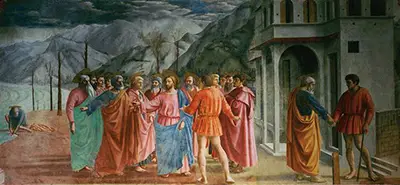 Buy Art Prints Now
Buy Art Prints Nowfrom Amazon
* As an Amazon Associate, and partner with Google Adsense and Ezoic, I earn from qualifying purchases.
The Tribute Money illustrates a thought-provoking scene that touches upon Masaccio's lust for depicting biblical scenes.
The artwork is a fresco conceived by Masaccio and another great artistic collaborator named Masolino.
Famous Renaissance artist, Masaccio, illustrates an ordeal of skill and technique throughout his artwork.
As the artist commonly loved to depict artworks that illustrated biblical scenes, due to their popularity of the time; the painting showcases a scripture event of the life of St. Peter. Located within the Gospel of Matthew, Jesus directs St. Peter to find a coin located in the mouth of a fish in order to pay a tax implemented by the state.
This captivating story is showcased throughout the painting as St. Peter walks with his apostles towards the waterfront seeking the fish. Masaccio depicts these figures in colourful attire as they stand near one another debating the matter. Shades of bright pink, orange, and green fill the fresco as the textiles of the apostles attire add colour to the artwork.
The artwork is well known as one of Masaccio's best paintings as he uses a horizontal perspective to analyze the artwork. The painting is a pivotal part of the Renaissance era as the viewpoint from which the painting is based was an innovative step in art. Masaccio positions his view from the middle of the artwork, gathering all of the figures together within the artwork.
Many paintings at the time of the 15th century were incredibly limited as they were only based on a two-dimensional viewpoint that did not showcase the full depth of the artwork. The significance of The Tribute Money is that Masaccio introduced a new viewpoint from which a three-dimensional texture occurred within the artwork. While the painting remains relatively flat in regards to the scenery, small strides of elongating techniques are evident within the artwork.
The head of Christ within the artwork acts as the vanishing point, as the remainder of the artwork is based along that aspect. This creates proportion as all figures as portrayed in relation to the angle of Christ. By using a vanishing point, depth is created causing the background of the work to seem broader.
The aerial perspective of the artwork allows for the landscape to seem much longer within the painting. Masaccio also worked towards illustrating the facial expressions of the figures in much more detail. The artist uses a natural light source from a section of the painting in order to bring the environment to life and accentuate the facial features. Masaccio uses a delicate approach to illustrate these details throughout the painting, as he follows a realist approach when illustrating the figures.
While the attention of the artwork falls upon Christ based on his classic features identifying his presence. Masaccio had singled out St. Peter as he paints him with his legs bare in comparison to the rest of the fully clothed men. This was a strategic technique of Masaccio as it enabled the artist to bring attention to another area of the painting.
The other two scenes that grab the viewerÕs attention are the displaced figures near the right and left of the painting. At the left we are able to see a man working on the bed of the sea. The interesting note to witness is that Masaccio displays this man with a aurora painted around his head in order to illustrate his holy presence.
To the right of the painting, Masaccio illustrates another two figures as an apostle talks to a common man. The common man is the individual within the painting that is not illustrated with an aurora around his head. It is fascinating to witness how the man on the left was considered a saintly individual, where as the man on the right was not.




